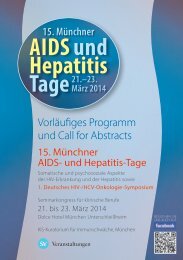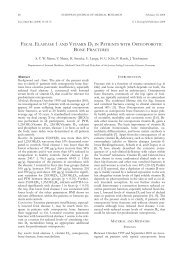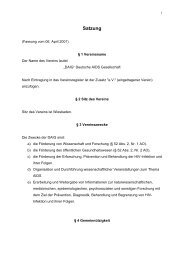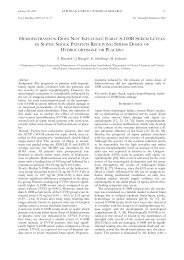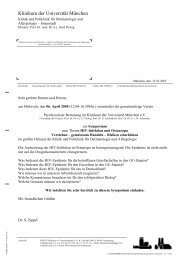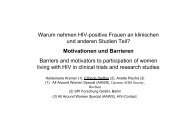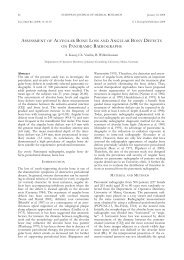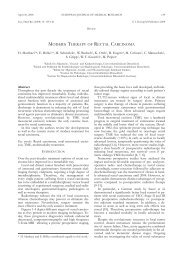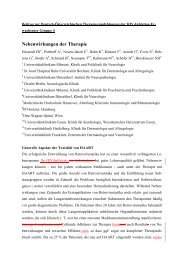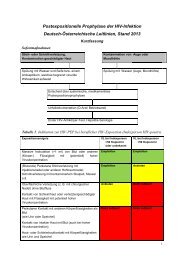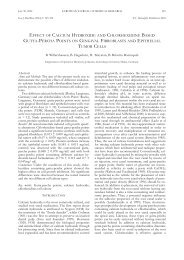European Journal of Medical Research - Deutsche AIDS ...
European Journal of Medical Research - Deutsche AIDS ...
European Journal of Medical Research - Deutsche AIDS ...
You also want an ePaper? Increase the reach of your titles
YUMPU automatically turns print PDFs into web optimized ePapers that Google loves.
June 27, 2007 EUROPEAN JOURNAL OF MEDICAL RESEARCH<br />
47<br />
A.55 (Vortrag)<br />
Children and young people living or working on<br />
the streets: the missing face <strong>of</strong> the HIV epidemic in<br />
Ukraine. A research report published by UNICEF<br />
Ukraine and <strong>AIDS</strong> Foundation East-West<br />
(November 2006)<br />
Teltschik A. 1<br />
1 Free-lance public health consultant (Eastern Europe &<br />
Central Asia), Odessa, Ukraine<br />
Objectives:<br />
1. To close an existing gap in research and to systematically<br />
assess and present:<br />
a) Needs and demands <strong>of</strong> the target group;<br />
b) Rights violations;<br />
c) National policy and legal frameworks;<br />
d) Available resources;<br />
e) Service quality and levels <strong>of</strong> coordination and cooperation.<br />
2. To provide recommendations and to guide the design, implementation<br />
and evaluation <strong>of</strong> an extended, comprehensive<br />
and multisectoral national response to prevention, treatment,<br />
care and support for this target group.<br />
Methods: A comprehensive situation and comparative analysis<br />
and a quantitative and qualitative survey among 650 children<br />
and young people living or working on the streets in<br />
Kiev and Odessa.<br />
Results:<br />
1. The phenomenon <strong>of</strong> children and young people living or<br />
working on the streets has been steadily increasing over the<br />
past 16 years in Ukraine.<br />
2. Most children run away from home, because <strong>of</strong> a dysfunctional<br />
family, abuse and the fact that there is no adequate social<br />
support system in place to address the problems at home<br />
and to prevent them from running away.<br />
3. But once the children and young people are living or working<br />
on the streets, their needs are also not being adequately<br />
met.<br />
Key research findings:<br />
a) This is a group most likely to be exposed to violence,<br />
abuse, discrimination, exploitation, HIV and many other diseases.<br />
b) They have a poor health status, very low education levels<br />
and their rights are being seriously violated.<br />
c) The majority are engaging in risk behaviour.<br />
d) They lack protection, as well as the means, skills, knowledge<br />
etc. to protect themselves.<br />
e) The services provided to them are <strong>of</strong> low quality.<br />
f) There is a lack <strong>of</strong> <strong>of</strong>ficial, standardized and reliable data.<br />
Conclusions: The target group represents only the ´tip <strong>of</strong> the<br />
iceberg´. ´Below the water´ is a large and growing number <strong>of</strong><br />
vulnerable children and young people in Ukraine, who are<br />
also most-at-risk and most affected by the HIV epidemic, and<br />
should therefore be at the centre <strong>of</strong> policy-making. The research<br />
report provides detailed recommendations to the<br />
Ukrainian government in key strategic areas on how to extend<br />
and improve the national response based on the experience<br />
gained in addressing the HIV epidemic over the past years in<br />
the country.<br />
A.56 (Poster)<br />
Knowledge, attitudes and behaviour in regard to<br />
HIV and STI among MSM in Austria, Slovak<br />
Republic, Italy and Slovenia – a BORDERNET<br />
cross border survey<br />
Amort F. 1 , Steffan E. 2 , Sokolowski S. 2 , Schnitzer S. 2<br />
1 <strong>AIDS</strong>-Hilfe Wien, Prävention, Wien, Austria, 2 SPI Forschung<br />
gGmbH, Berlin, Germany<br />
Objectives: BORDERNET (EU funded) aims to enhance<br />
HIV/<strong>AIDS</strong> and STI-prevention, diagnostic and therapy in regions<br />
across the old and the current EC-outer borders. In<br />
Western Europe in general over one third (35%) <strong>of</strong> the HIV<br />
infection diagnosed in 2005 occurred through sex between<br />
men. The epidemics range in Central Europe remains still<br />
small in comparison, but also here sexual contacts between<br />
MSM are an important source <strong>of</strong> infection.<br />
Methods: Two BORDERNET model regions (MR 3 – Austria/Slovakia,<br />
MR 4 – Italy/Slovenia) decided to make MSM<br />
to one <strong>of</strong> their target groups for a BORDERNET KAB survey<br />
with additional questions on mobility. Based on preliminary<br />
defined selection criteria <strong>of</strong> gay friendly venues, a total number<br />
<strong>of</strong> 371 MSM was questionned with a self-administration<br />
questionnaire.<br />
Results: In regard to cross border mobility, the MSM respondents<br />
from Slovenia and Slovakia are the most frequent travellers<br />
to the neighbouring countries, whereas the Austrian<br />
men are moderate travellers and the Italian travel even more<br />
seldom. Leisure time is the most important reason for travelling<br />
across the borders.<br />
Even though the respondents showed a very high basic<br />
knowledge <strong>of</strong> HIV/<strong>AIDS</strong>, there are also many insecurities as<br />
well as fears to get infected with HIV. A high percentage <strong>of</strong><br />
MSM have been tested for HIV (Austria: more than 90%),<br />
and a high proportion <strong>of</strong> them stated to have received pre- and<br />
post test counselling.<br />
Concerning condom use, different patterns <strong>of</strong> risk management,<br />
such as consequent safe sex, being faithful, decrease <strong>of</strong><br />
number <strong>of</strong> partners, serosorting, seropositioning and avoidance<br />
<strong>of</strong> risky venues could be identified in all countries. More<br />
risky behaviour was stated with steady partners than with casual<br />
ones. Over 20% <strong>of</strong> the men reported an STI diagnosis in<br />
the last two years, Italian MSM showed the highest incidence<br />
here.<br />
Discussion: A main challenge <strong>of</strong> the combined HIV and STI<br />
prevention among MSM is to handle the consequences <strong>of</strong> the<br />
“normalisation” process <strong>of</strong> HIV. Cross border prevention<br />
strategies for MSM might be a possibility to reach synergetic<br />
effects and should particularly focus on irrational fears and<br />
risk management strategies and help to overcome still existing<br />
prejudices and misconceptions.<br />
A.57 (Poster)<br />
Ansatz der Bewertung einer HIV-Infektion bzw.<br />
<strong>AIDS</strong>-Erkrankung in Österreich, 2006<br />
Schröck T. 1<br />
1 Donauuniversität Krems, Wien, Austria<br />
Fragestellung: Behandlungskosten von HIV bzw. <strong>AIDS</strong><br />
waren in Österreich bislang unbekannt. Daher wurde im Vorfeld<br />
der Studie beschlossen, den Ansatz einer Bewertung<br />
vorzunehmen.



